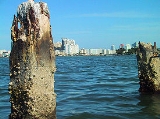
Isola di Lolando
Encyclopedia


Florida land boom of the 1920s
The Florida land boom of the 1920s was Florida's first real estate bubble, which burst in 1925, leaving behind entire new cities and the remains of failed development projects such as Aladdin City in south Miami-Dade County and Isola di Lolando in north Biscayne Bay...
burst in the mid 1920s as a land boom fueled by outside speculators was stricken by economic realities and unexpected hurricanes. One failed development project left its remains scarring north Biscayne Bay
Biscayne Bay
Biscayne Bay is a lagoon that is approximately 35 miles long and up to 8 miles wide located on the Atlantic coast of South Florida, United States. It is usually divided for purposes of discussion and analysis into three parts: North Bay, Central Bay, and South Bay. Its area is...
near Miami Beach, Florida
Miami Beach, Florida
Miami Beach is a coastal resort city in Miami-Dade County, Florida, United States, incorporated on March 26, 1915. The municipality is located on a barrier island between the Atlantic Ocean and Biscayne Bay, the latter which separates the Beach from Miami city proper...
. Concrete pilings from the sea wall of the incomplete Isola di Lolando still remain perfectly aligned in the shape of a new "Venetian island
Venetian Islands, Miami Beach, Florida
The Venetian Islands are a chain of artificial islands in Biscayne Bay in the cities of Miami and Miami Beach, Florida. The islands are, from west to east: Biscayne Island , San Marco Island , San Marino Island , Di Lido Island , Rivo Alto Island , and Belle Isle...
", stretching from the northern tip of Di Lido Island
Di Lido Island, Miami Beach, Florida
Di Lido Island is an artificial island in the city of Miami Beach, Florida, United States. It is the third island from the east of the Venetian Islands, a chain of artificial islands in Biscayne Bay in the cities of Miami and Miami Beach. It is between San Marino Island and Rivo Alto Island. It...
to the Julia Tuttle Causeway.
The pilings sit in about 5-10 feet of water and extend about 5-10 feet above the water, depending on the tide. The pilings and the island's outline shape are clearly visible from the Julia Tuttle Causeway as well as from many of the tall buildings that overlook the bay. They present a clear hazard to boat navigation and the interior of the island is a peaceful place that remains free of boat and jet ski traffic for kayakers, dolphin, manatee, sting rays, manta rays, and many types of fish.
History
In the early 1920s audacious developers like John S. CollinsJohn S. Collins
John Stiles Collins was an American Quaker farmer from Moorestown Township, New Jersey who moved to southern Florida and attempted to grow vegetables and coconuts on the swampy, bug-infested stretch of land between Miami and the ocean, a barrier island which became Miami Beach.Although the farming...
were known for selling pre-construction property in the middle of Biscayne Bay before the islands had even been built. Demand was strong and there was virtually no environmental regulation, leading developers to envision filling Biscayne Bay with artificial islands. With unlimited waterfront property available, it seemed that the land boom had no end in sight.
The Shoreland Company and The Venetian Island Company were attempting to build a chain of new Venetian Islands in the water south of the Julia Tuttle Causeway in north Biscayne Bay
Biscayne Bay
Biscayne Bay is a lagoon that is approximately 35 miles long and up to 8 miles wide located on the Atlantic coast of South Florida, United States. It is usually divided for purposes of discussion and analysis into three parts: North Bay, Central Bay, and South Bay. Its area is...
. The first was to stretch from the causeway to Di Lido Island, and was to be called Isolda di Lolando, continuing the Venetian theme of the existing successful artificial island projects.
In 1925 the population explosion in South Florida had begun to strain local resources, and railway shipping companies began raising prices. In October the old Danish war ship Prinz Valdemar capsized in the channel in the port of Miami on its way to becoming a floating hotel, blocking shipping access to Miami for weeks. That summer brought the 1926 Miami Hurricane
1926 Miami Hurricane
The 1926 Miami hurricane was a Category 4 hurricane that devastated Miami in September 1926. The storm also caused significant damage in the Florida Panhandle, the U.S. state of Alabama, and the Bahamas...
, which devastated an unprepared populace and heavily damaged local infrastructure. The Shoreland Company went bankrupt in 1927 amid objections to "further mutilation of the waterway". The 1929 stock market crash and subsequent onset of the Great Depression
Great Depression
The Great Depression was a severe worldwide economic depression in the decade preceding World War II. The timing of the Great Depression varied across nations, but in most countries it started in about 1929 and lasted until the late 1930s or early 1940s...
ensured that Lolando Island was never completed.

